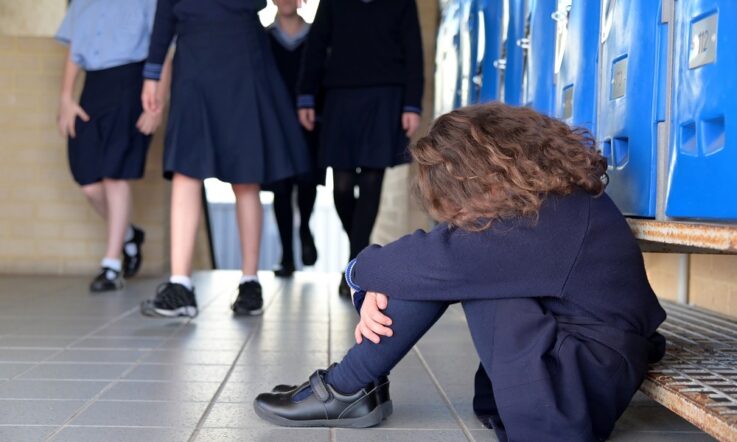This podcast from Teacher is supported by Bank First – the bank built by teachers for teachers. Visit bankfirst.com.au or speak to us to find out how your home loan or savings can care for the community like you do.
Thanks for tuning in to this episode of Teacher Staffroom, where we catch you up on the latest evidence, insight, and action in education. I'm Zoe Kaskamanidis.
Teacher welfare has always been a critical issue in education, and in the past few years, we’ve seen the pandemic pose a variety of new challenges for teacher workload, stress, burnout and attrition. This month at Teacher, we’ve shared some stories about teacher welfare from a range of perspectives – from accessing supports at your own school, to coping with violence from students, and navigating vicarious trauma.
In today’s episode I’m going to get you up to speed on these stories, and also some of my highlights from this month. And, like all episodes of Teacher Staffroom, I’ll be posing some questions throughout the podcast, so feel free to pause the audio as you go, gather some colleagues and discuss together how these stories might be relevant to your school context.
Before we jump into this episode, it would be great if you could take just a few moments to give a rating of our podcast if you’re listening to this audio on Apple podcasts or Spotify. If you’re listening on the Spotify app, just click on the three dots, then ‘rate show’, and if you’re on the Apple podcasts app you’ll find the rating section by scrolling to the bottom of our podcast channel page. On Apple podcasts, you’re also able to leave a short review for us. Leaving us a rating or a review helps more people like you to find our podcast, and is a really big support for our team.
Thanks for taking the time to support the work we’re doing. Let’s dive into this episode.
The first piece I’d like to share with you is a Q&A with Margaret Horton, Senior Vice Principal at Methodist Ladies College. In this Q&A, we asked Margaret about how the school has built up a culture of teacher wellbeing which has encouraged increased staff access of their Employee Assistance Program.
Many of you will be familiar with Employee Assistance Programs (or EAPs) which are facilitated by external providers to offer staff free wellbeing supports such as counselling, for issues both in and outside of work. While EAPs are very common in schools, they’re actually very underutilised.
Like me, you might be surprised to hear that the industry standard utilisation rate of EAPs in education is only 1.8%. At MLC, however, the school has worked hard to reach a 4% utilisation rate – over double the industry standard.
Margaret shared with us that a key factor contributing to the school’s EAP utilisation has been the broader focus on staff welfare, and making sure staff feel confident and comfortable enough to make use of the supports the school has to offer. For example, ensuring wellbeing programs [are] emphasised through the Principal’s weekly newsletter, having dedicated wellbeing staff ambassadors and introducing daily wellbeing check-ins during the pandemic.
So, this brings me to my first question for you to reflect on. In your own school setting, think about what kinds of wellbeing supports are available to staff, and how you could take the first step to access them. If the answer isn’t clear, consider why. Is there more your school could be doing to make sure staff know what supports are available to them?
The next piece I’d like to highlight shares the findings from a new study which looks at Australian teachers’ experiences of lockdown learning during the pandemic. The study was run by Professor Penny Van Bergen, Head of the University of Wollongong’s School of Education, and Macquarie University’s Emily Daniel, during the first wave of the pandemic in Australia, in March 2022.
The researchers surveyed 210 teachers from across Australia about the positive and negative changes in their role as a result of the pandemic. The study participants comprised 164 secondary teachers, 37 primary teachers and 10 specialty teachers from a range of government, independent and Catholic schools.
The analysis of responses found that 88.6% of respondents reported negative themes and 44% reported positive themes in the changes to their role during the pandemic.
Something that really stood out to me with this study was the space given to teachers’ own explanations of their experiences during the pandemic, rather than the broader, more general data collection we often see in relation to the impact of global events such as the pandemic.
Here is an excerpt from the study itself, where one of the researchers talks about the significance of sharing these perspectives:
‘While COVID-19 has now been empirically associated with additional stress and exhaustion for teachers, particularly related to work-life balance, technology issues, and concerns for students … it is important that educational leaders, policymakers, and researchers also understand what teachers themselves considered the biggest challenges in their roles when transitioning to remote learning.’
So let’s pause here for a moment, to think about the implications of this study within your own school context, in terms of how you plan for the future. And this might be one for the principals and leading teachers listening, or something you might like to raise in your next staff meeting. How might your school ensure that teacher’s perspectives and experiences of teaching inform what kinds of supports are available for their wellbeing during future challenges in education?
Before we jump into our next highlight, here’s a quick message from our sponsor.
You’re listening to a podcast from Teacher magazine, supported by Bank First. Bank First is proudly Customer Owned – built by people just like you. Being Customer Owned means we can divert our profits to support initiatives you care about. Like $750,000 towards grass roots initiatives in schools since 1983. Your Bank First home loan can get you into your own home and support education for our kids. Email talktoabanker@bankfirst.com.au for more information.
Challenges to teacher welfare can take many forms. Like we’ve just discussed, they can be larger, structural challenges external to the school such as COVID-19, but they can also come from the interpersonal relationships in teaching, such as those between teachers and students.
We’re going to pivot now to talk about some recent content we’ve shared which looks at teacher welfare in relation to student-teacher relationships and interactions.
So I’d like to highlight a podcast we recently did as part of our Research Files series. And the focus of this episode is on student violence directed at school educators. Editor of Teacher, Jo Earp, spoke with David Stevenson, a provisional psychologist and behaviour support practitioner, and Assistant Professor James Neill from the Discipline of Psychology, School of Health Sciences and Faculty of Health at the University of Canberra.
Stevenson and Neill, along with other researchers, worked on a study on the frequency and impact of occupational violence for educators working in pre-school to Year 6 in the Australian Capital Territory, and prevention and coping strategies they used and found effective.
Alarmingly, the rates of verbal abuse and threats, harassment and violence towards educators is 9 to 10 times higher than that of the general population, and the researchers found from participants’ responses that, for educators, around half their day on average is used up managing these challenging and complex behaviours.
In the podcast, besides unpacking in detail the impact of violence from P-6 students toward their educators, Stevenson and Neill explore prevention and coping strategies. Like the study in my last highlight, these strategies came from educators themselves which were then coded and sorted into 14 themes. There’s so much which was explored in this podcast, so I’d encourage you to go back and take a listen if you haven’t already.
But for now, here’s a snippet that really stood out to me on what schools can do now, in practical terms, to help prevent occupational violence from students towards teachers:
‘In relation to prevention, staff support and training regarding the interaction styles, identifying underlying causes for aggressive behaviour, and teaching alternate behaviours – which I know is done very well in Australia with a lot of the evidenced-based intervention programming that we do. Whenever possible removing antecedents, which is not always possible – we can only do the best to sort of help control and minimise from that angle, but doing the best we can. And that really leads back to the forming of really quality relationships and understandings with our students.’
If you’re a teacher listening right now and you feel able to do so, take a moment to reflect on a time you were exposed to violence by a student. Were you able to develop an understanding of any triggers or early warning signs that may have contributed to this incident? How could you use this knowledge to attempt to prevent a similar incident occurring in the future?
So, my last highlight I think flows on quite nicely from the last. And it’s a submission from Dr Emily Berger, Educational and Developmental Psychologist at Monash University.
In her article, Emily takes a look at vicarious trauma in teacher practice. And by vicarious trauma (also known as secondary trauma) we’re talking about the experience of symptoms of post-traumatic stress through hearing about the details of other people’s trauma, or responding to the mental health needs and distress of traumatised people over time.
Emily explains that teachers can experience vicarious trauma when exposed to details, especially repeated details, of a student’s traumatic experience – even if you haven’t experienced that trauma yourself.
Because teachers’ experience of vicarious trauma is closely tied to students’ trauma, she also covers the benefits of trauma-informed practice as an evidence-based approach designed to help teachers manage the needs of traumatised students, and some of the trauma-informed strategies to implement both in the classroom and at a whole-school level.
As opposed to vicarious trauma, Emily also explores the concept of vicarious resilience – what happens when people don’t experience that distress when working with traumatised people. I’ll end with reading you part of Emily’s article, where she lists some of the strategies which can help to build teachers’ vicarious resilience. She writes:
‘Resources and coping mechanisms include showing empathy and changing one’s perspective on life based on exposure to traumatised people, sharing hope and positive reflections with people exposed to trauma, practices that affirm and support coping strategies of traumatised people, and increasing self-awareness and self-care around one’s own coping when working with traumatised people.’
So, reflecting on your own school context, is there an awareness of how student trauma can affect teachers’ wellbeing? If you’re listening as a leading teacher or principal, are teachers aware of how they can implement trauma-informed classroom strategies? And are supports in place for teachers who may be experiencing vicarious trauma?
That's all for this episode, and now you’re all caught up on the latest evidence, insight and action. Links to all the content and resources I’ve mentioned will be in the transcript of this podcast available over at our website, teachermagazine.com.
Subscribe to our podcast channel on Spotify, Apple podcasts, SoundCloud, or wherever you get your podcasts from, so you can be notified of any new episodes as soon as they land. If you want to keep listening now, you can access the 200+ episodes already in our archive.
You’ve been listening to a podcast from Teacher, supported by Bank First – the bank built by teachers for teachers. Visit bankfirst.com.au or speak to us to find out how your home loan or savings can care for the community like you do.



